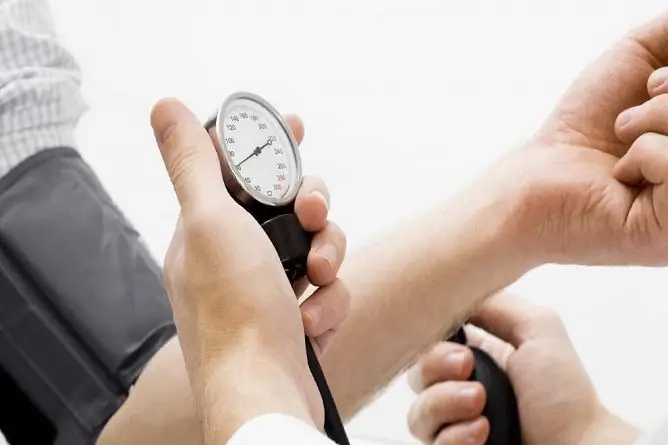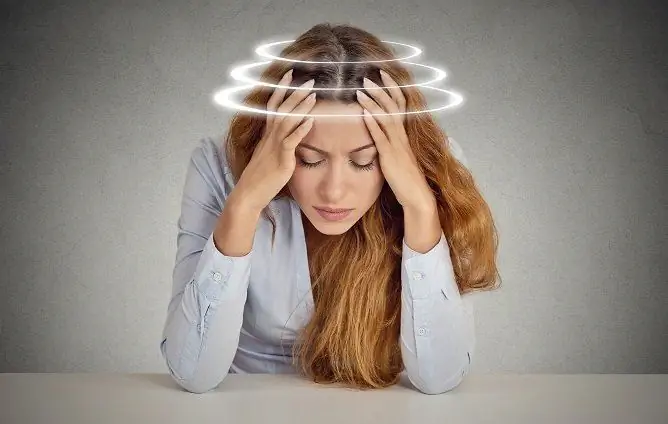- Author Rachel Wainwright [email protected].
- Public 2023-12-15 07:39.
- Last modified 2025-11-02 20:14.
High lower pressure: causes, symptoms, treatment
The content of the article:
- Why is the lower pressure increased - the causes of pathology
- Signs of increased lower pressure
- How to treat high diastolic pressure
- Understanding Upper and Lower Pressure
- Video
The causes of high lower pressure can be a variety of both physiological and pathological factors. Increased lower pressure is diagnosed when a value of 90 mm Hg is reached. Art. and higher. This can lead to a deterioration in the condition of the blood vessels and blood supply to organs and tissues of the body. As a rule, the heart, brain, kidneys are primarily affected, and the risk of stroke and myocardial infarction increases significantly. For this reason, if you suspect an increase in lower pressure, you should seek medical attention.

An increase in the lower pressure is usually combined with an increase in the upper
Why is the lower pressure increased - the causes of pathology
Diastolic pressure is more constant and stable than systolic pressure. There are a number of reasons why the lower pressure rises, which include narrowing of blood vessels, decreased elasticity of blood vessels, and disruption of the heart.
The main reasons for an increase in lower pressure with a normal upper pressure include significant atherosclerotic damage to blood vessels, a decrease in the production of thyroid hormones, heart and / or renal failure, myocarditis, cardiomyopathy, cardiosclerosis.
Risk factors for increased lower pressure are: genetic predisposition, the presence of bad habits, overweight, excessive physical and mental stress, passive lifestyle, occupational hazards.
The reasons for the combined increase in systolic and diastolic pressure can be hypertension, increased production of thyroid hormones, increased adrenal function, glomerulonephritis, atherosclerosis of the renal arteries, excessive mental stress, frequent stressful situations, pituitary neoplasms, intervertebral hernia, and the use of excessively salty fatty foods. In women, an increase in pressure can be observed in late pregnancy, which is dangerous by the development of gestosis. Often, blood pressure rises with menopause.
Signs of increased lower pressure
An increase in blood pressure is often asymptomatic or asymptomatic for a long time. With the development of arterial hypertension (hypertension), the patient often does not even suspect about it until the first hypertensive crisis. Diastolic hypertension has no specific symptoms, its manifestations are the same as those of ordinary arterial hypertension.
Headache with increased diastolic pressure can be aching, bursting, pulsating, it is usually localized in the frontal, parietal and / or temporal regions. Patients with high lower pressure are worried about pain in the heart, which is accompanied by a pronounced heartbeat, high pulse and a feeling of lack of air, tremors throughout the body, dizziness, tinnitus. In some cases, patients have swelling of the extremities, increased sweating, hyperemia of the facial skin.
With a combination of systolic and diastolic hypertension, the risk of developing myocardial infarction, dissecting aortic aneurysms and stroke increases significantly.
How to treat high diastolic pressure
First aid for a sudden increase in lower pressure is that a person should be laid down or helped to take a half-sitting position, provide him with fresh air, and get rid of clothes that are holding the body down. If the patient has been prescribed pills by the doctor, which he can take in case of high blood pressure, you need to give them to him.
The treatment of high blood pressure can be dealt with by a therapist, cardiologist; in some cases, consultations of a neuropathologist, endocrinologist and other specialists are necessary.
When treating high lower pressure, the first step is to eliminate the provoking factor.
What medication to take with high diastolic pressure depends on the cause of the hypertension, the patient's condition, the presence of concomitant diseases and a number of other factors. You should not self-medicate; only a qualified specialist should select therapy for high diastolic pressure.
Drug therapy may consist in the appointment of angiotensin-converting enzyme inhibitors, angiotensin prescriptions (in monotherapy or in combination with diuretic drugs), beta-blockers, calcium channel blockers, diuretics, antispasmodic drugs. The therapy is long-term, sometimes lifelong.
In addition to the main treatment for high diastolic pressure, folk remedies based on valerian, motherwort, peony, peppermint, lemon balm, hawthorn, and cedar cones can be used.
If the diastolic pressure is outside the upper limit of the norm, the patient is shown diet. First of all, it is required to significantly limit the consumption of table salt. The diet is recommended to include foods rich in potassium, which include cucumbers, tomatoes, beets, cabbage, peppers, watermelons, bananas, melons, dried fruits, nuts. Products containing magnesium are useful (cottage cheese, sour cream, millet, buckwheat, beans, soy, apricots, strawberries, raspberries). In addition, it is recommended to eat beef, rabbit meat, pork liver, apples, carrots, pears, cherries, apricots and other foods rich in B vitamins. the same time).
It is important to establish a night's sleep - patients with high diastolic pressure should sleep at least 8 hours a day. At the initial stage of hypertension, with the help of lifestyle changes, exercise therapy and diet, blood pressure can be normalized even without taking medications.
Understanding Upper and Lower Pressure
Blood pressure (BP) is an indicator that reflects the level of pressure that blood exerts on the walls of blood vessels while moving along them. A blood pressure of 120 to 80 mm Hg is considered normal. Art.
Blood pressure consists of two indicators - upper (systolic) and lower (diastolic). The difference between the upper and lower pressure is called the pulse pressure and should be approximately 40 mmHg. Art. with a tolerance of 10 mm Hg. Art. up or down. Blood pressure is one of the most important indicators of human health, it can change for a short time in a number of physiological processes, and also indicate a number of diseases with a persistent deviation from the norm.
According to the relationship with systolic pressure, an isolated increase in only diastolic pressure (diastolic hypertension), a combined increase in systolic and diastolic pressure (systolic-diastolic hypertension) are distinguished. An isolated increase in only the lower pressure occurs in about 10% of cases.

People prone to arterial hypertension need to constantly monitor their blood pressure.
Arterial hypertension is subdivided into 3 degrees (stages):
- Mild - the patient's diastolic pressure is 90-100 mm Hg. Art.
- Average - 100-110 mm Hg. Art.
- Severe - 110 mm Hg Art. and higher.
If you suspect the presence of a pathology, you should consult a doctor who will explain what the increased lower pressure means, what it means, why this condition occurs, and what to do in such a situation.
To diagnose pathologies that are accompanied by an increase in diastolic pressure, it is usually necessary to conduct electrocardiography, Doppler ultrasonography of the blood vessels of the brain, laboratory and other studies. In some cases, increased blood pressure is detected by chance during a routine medical examination or diagnosis for another reason.
If a person has a consistently high blood pressure, he needs to regularly monitor it at home using a tonometer.
The most effective treatment of high lower blood pressure with newly developed diastolic hypertension in a person under the age of 50 in the absence of a history of serious illness. With a constantly increased lower pressure for 5-10 years in people after 50 years in 80-82% of cases, the prognosis worsens.
Video
We offer for viewing a video on the topic of the article.

Anna Aksenova Medical journalist About the author
Education: 2004-2007 "First Kiev Medical College" specialty "Laboratory Diagnostics".
Found a mistake in the text? Select it and press Ctrl + Enter.






